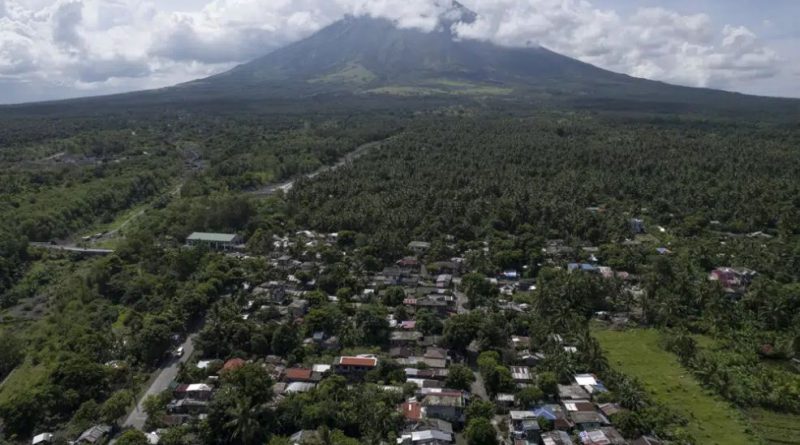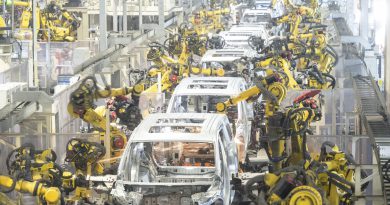Poor villagers risk their lives in danger zone as Philippines’ most active volcano erupts
Calbayog (AP) — Delfina Guiwan’s heart was pounding as she snuck back to her village, now abandoned and eerily quiet, in the fertile foothills of gently erupting Mayon volcano in the northeastern Philippines.
When patrolling police spotted her, they warned that the village is off-limits because of the danger of a violent eruption at any time. Guiwan, 47, said she knew the risks but begged to stay a few minutes more to get her daughter’s school uniform from their shack and feed her pigs.
“I’m scared. We saw lava flowing down one night and a boulder rolled down, sounding like thunder,” Guiwan told The Associated Press. “I’m praying this eruption won’t get worse because our livelihood is here and it’s difficult to stay in the evacuation camp with few toilets for so many, and the heat. Children are getting sick there.”
Her village, Calbayog, lies in Mayon’s northeastern foothills and is well within the 6-kilometer (3.7-mile) radius from the volcano’s crater that officials have long designated a permanent danger zone, demarcated by concrete warning signs. Entry is prohibited, but thousands of poor villagers have flouted the restrictions and made it their home for generations. Lucrative businesses such as sand and gravel quarrying and sightseeing tours have also thrived openly despite the ban and the mountain’s frequent eruptions — now 53 times on record since 1616.
The 2,462-meter (8,007-foot) volcano is one of the Philippines’ top tourism draws because of its near-perfect cone shape. But it’s also the most active of the country’s 24 volcanoes and could erupt violently at any time.
That includes pyroclastic flows, which are superheated gas and volcanic debris that suddenly race down slopes at great speed and incinerate everything in their path. Another threat is lahar, a muddy stream of water, volcanic ash and rocks that can move as fast as cars and engulf areas up to several kilometers (miles) away.
A terrifying symbol of Mayon’s deadly fury is the belfry of a 16th-century Franciscan stone church which protrudes from the ground. It’s all that’s left of a baroque church that was buried by lahar along with the town of Cagsawa in an 1814 eruption which killed about 1,200 people, including many who sought refuge in the church, about 13 kilometers (8 miles) from the volcano.
The thousands of villagers who live within Mayon’s danger zone reflect the plight of many impoverished Filipinos who are forced to live in dangerous places across the archipelago — near active volcanoes like Mayon, on landslide-prone mountainsides, along vulnerable coastlines, atop earthquake fault lines, and in low-lying villages often engulfed by flash floods, said Richard Gordon, the longtime chairman of the Philippine Red Cross and a former senator.
Each year, about 20 typhoons and storms lash the Philippines, which also lies along the Pacific “Ring of Fire,” an arc of fault lines along the Pacific Ocean basin often hit by volcanic eruptions and earthquakes.
“It’s really a problem of poverty,” Gordon said, adding that the government should prepare a comprehensive plan to provide poor villagers with safe housing and sustainable livelihoods that would finally allow them to abandon high-risk settlements.
“They go there because they have no choice,” Gordon said in a telephone interview.
Most residents were evacuated from Guiwan’s village, Calbayog, last week when Mayon started to gently expel lava after days of unrest. Only the chirps of birds and crickets, the crowing of roosters and rustling of coconut trees in the cool breeze could be heard in the village, about 4 to 5 kilometers (2.5 to 3 miles) from the volcano.
AP journalists were allowed by police to briefly join a house-to-house patrol of a Calbayog neighborhood and saw a few defiant residents still in their houses. One villager insisted to police that he had to remain because the 40 roosters he had bred for cockfights might be stolen if he left. Dance music or radio news broadcasts could be heard at two houses, and at least three others had laundry hanging on clotheslines in the sun.
At Mi-isi, another village well inside the permanent danger zone in Mayon’s southeastern foothills, longtime resident Miniong Asilo laughed off warnings from authorities and volcano scientists.
“I’m not scared, but outsiders will probably have a heart attack if they live here,” the 54-year-old father of nine said, adding that he has lost count of the times he has witnessed Mayon’s fury.
Asilo and his family have survived for decades off the proceeds from his vegetable farm, piggery, coconut grove and on-and-off work as caretaker of a nearby gravel and sand quarry.
“I was born here. I have not seen the fire and lava reach this village,” Asilo said.
As he spoke, Mayon rumbled faintly and lava flowed from its swollen crater a kilometer (more than half a mile) down a gulley near the village, in what scientists have described as a “very gentle” eruption so far.
But the government isn’t taking any chances.
Since the volcano began expelling lava a week ago, soldiers, police and local officials have moved more than 20,000 villagers from the danger zone in forced evacuations to 28 temporary shelters, mostly schools, according to the government’s disaster-response agency.
With most classrooms now crammed with impoverished evacuees and their belongings, teachers have been forced to hold classes in school corridors, in chapels and under trees, Albay provincial education official Alvin Cruz said.
The crisis is an additional challenge for President Ferdinand Marcos Jr., who took office in June last year and inherited an economy battered by the coronavirus pandemic, which deepened poverty, unemployment, hunger and the country’s debt. He flew to Albay on Wednesday to hand out food packs and reassure the evacuees of government help, but warned that Mayon’s gentle eruption may drag on for months, keeping them away from their homes.
The number of displaced villagers could more than double if Mayon’s eruption turns violent and life-threatening, which government volcanologists say is still possible within days or weeks. That could prompt an expansion of the danger zone and the forced evacuation of many more residents.
Thousands of villagers have been given homes away from Mayon in the past, but many returned to its fertile slopes because of inadequate livelihood options in government-established relocation sites, said Eddie Nunez, a resident of Bonga village, about 8 kilometers (5 miles) from Mayon’s crater.
Nunez, 59, lost an uncle and cousin when they were hit by volcanic ash, steam and boulders in a sudden 1993 explosion while farming on Mayon’s lower slopes. Dozens of other farmers were also killed, he said.
The lack of jobs and opportunities elsewhere forces people to continue risking their lives farming vegetables and scrounging for other sources of income at the foot of the volcano, Nunez said, comparing the choice to Russian roulette.
“You either get lucky or you get hit,” he said.



